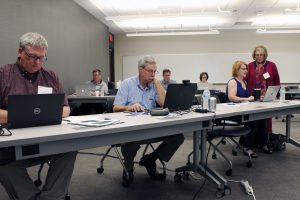Eight IT Employer Perspectives
The National Convergence Technology Center (CTC) recently convened its Business and Industry Leadership Team (BILT) for its summer quarterly meeting. As always, a good portion of this BILT meeting was devoted to discussing trends in the IT workplace. If you’re not already encouraging these kinds of talks with your employers, you should consider adding them to your meeting agenda. In between the larger annual KSA votes (which we also hope everyone is doing!) that prioritizes entry-level knowledge, skills, and abilities, these shorter “trends talks” keep educators up-to-date on the ongoing evolution of IT. Typically, the CTC’s trends talks run 30-40 minutes. Sometimes we’ll introduce a prompt question to kick off the discussion, sometimes we’ll find workforce charts and ask for industry feedback, sometimes we’ll arrange in advance for certain employers to address specific topics.
To learn more about what the CTC calls the “BILT model,” you can watch a webinar or download our updated toolkit.
Here’s a quick rundown of some of the more interesting statements that came out of our August meeting.

1. Small businesses face challenges getting cybersecurity insurance policies, which are becoming more complicated. Years ago, business owners only had to answer three questions. Now it’s pages and pages of questions that must be addressed, much of it is built around multi-factor authentication and password management. In addition, it’s not enough to just answer the questions – more and more, businesses have to provide proof that they’re following the practices they say they’re following. You can’t get the insurance if you don’t meet the standards.
2. One BILT member who works in the collaborative space noted that the predicted migration of business into the cloud hasn’t happened. Customers won’t go into the cloud without “full feature parity.” And, in fact, big companies will never go all the way into the cloud. They will always keep some on-prem capability. Hybrid will probably be the answer for “a very long time.”
3. Others agreed on-prem won’t entirely go away, whether for compliance purposes or customer preference. Students need to understand the pros and cons of implementing one over the other, whether it’s cost or scalability or some other factor.
4. Students need to get one of the big three certifications for cloud – AWS, Azure, or Google. One BILT member stated his belief that it will be hard to get an interview without one of those industry certifications.
5. When pushing content to the cloud, keep in mind the concept of “shared responsibility.” When moving to the cloud, the only thing you’re relinquishing is the infrastructure and the hardware. The business owner is still the one responsible for securing and upkeeping the data. It’s not the cloud provider’s responsibility.
6. Programs may want to consider inviting guest speakers from different industries. This is one way to add up-to-date content without having to modify existing classes. Specifically, bring in a CIO or technical executive to talk about their company, their challenges, and their technologies. Guest speakers can help students better understand what the work will really look like.
7. The growing adoption of SASE (secure access secure edge) is pushing security up into the cloud, which means more and more users don’t have network equipment on site. This eliminates the need for VPN since it’s “always on.” The challenge is that so many small business owners don’t have necessary expertise in technology.
8. Small businesses often have to rely on DIY no-code solutions – such as those sold by services like Shopify – because they don’t have skilled IT technicians on staff.
